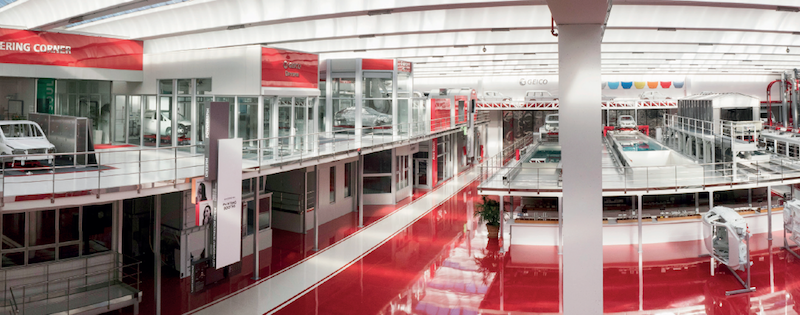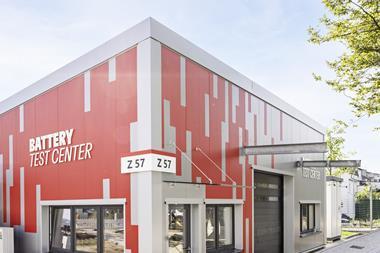
Geico COO Daryush Arabnia talks about how humans and machines use I4.0 concepts in the paintshop
 We have discussed in the past the way in which Geico has embraced Industry 4.0 concepts in its paintshop developments. How are these concepts taking shape?Daryush Arabnia: Industry 4.0 has had a big impact and we have now developed a structure of linked elements that offer our customers a real benefit. The adoption of Industry 4.0 has meant a transformation in the way we work, as well as the way our customers work. It has brought an integration of the various elements in our offer to our customers. The way we think of it is rather like a Greek Temple: at the base is our Smart Design, on which everything rests. Then we have four pillars – practical themes that form the focus of our work and are rooted in Industry 4.0. Finally, on the top as it were, we have our J-Suite system – our ‘Avatar’ of the facility or plant that makes possible proper control, planning and integration of all these elements along with high levels of self-learning and adaptation.
We have discussed in the past the way in which Geico has embraced Industry 4.0 concepts in its paintshop developments. How are these concepts taking shape?Daryush Arabnia: Industry 4.0 has had a big impact and we have now developed a structure of linked elements that offer our customers a real benefit. The adoption of Industry 4.0 has meant a transformation in the way we work, as well as the way our customers work. It has brought an integration of the various elements in our offer to our customers. The way we think of it is rather like a Greek Temple: at the base is our Smart Design, on which everything rests. Then we have four pillars – practical themes that form the focus of our work and are rooted in Industry 4.0. Finally, on the top as it were, we have our J-Suite system – our ‘Avatar’ of the facility or plant that makes possible proper control, planning and integration of all these elements along with high levels of self-learning and adaptation.
Underpinning it all is Smart Design?Yes. It’s a web-based platform that allows customers to get very quick costing for various alternative plant proposals. The system contains all the data we have acquired from our experience in building paintshops, along with any specific data we might have from previous contact with the particular customer. It is linked to our suppliers, and allows our engineers and the customer to very quickly work out costings and illustrate the relationship between particular choices and their cost implications.
As the proposal develops, and the customer provides us with more data on their requirements and constraints, so the plans can be formulated and refined. The big benefit is speed. We can respond to enquiries in days rather than weeks, and build up proposals in a short space of time. This is very often a key issue for our customers.
How do the four pillars relate to the needs of customers?Think of the pillars as solutions if you like. The first pillar is IoT – we have a Smart Process Skid – an IoT system that allows us to use simulation and virtual reality processes in the implementation and commissioning phases of paintshop development. Using big data allows us to establish base settings for the equipment and establish and model workflows in the new plant. In fact, the integration of each element within the plant is accomplished while equipment is still being delivered and installed so, once again, time is saved and new plants can be got up and running with minimum delay. At the same time preventative maintenance schedules can be established, and crucial quality control processes put into place. Of course all these initiatives have self-learning capacity so very quickly, as production is developed, so the settings and processes are adapted in the light of a continual feedback loop.
With Quality Control for example it is not just a question of defect identification. Rather it involves the automatic networking of this defect information to operators through facemask – Augmented Reality - screens and the incorporation of their judgments and evaluations during the rectification process, as well as adjustments perhaps to air supply and similar variables.
That is the IoT system. What are the other pillars of your Temple?Secondly we have Smart Energy Management. As you know for many years we have been working really hard to develop energy management systems in order to reach our Energy Independence Day. To make all these paintshop processes truly sustainable. This area of work has been really important, both for the environment and for our customers’ profitability. Our J-Power software simulations allow us to optimise the energy options for our customers wherever they may be operating. The system facilitates long-term investment, planning, and exploration of the renewable energy options.
Our Smart Booth technologies allow sophisticated control of air supply and the drying processes, with significant reduction in energy use and enhanced flexibility. Of course our software is configured to allow the input of data from the local energy providers and is continually adapting to changed requirements and new data. In this way the whole factory can have its energy usage monitored and adjusted seeking the solutions to maximize performance, ensure sustainability and minimize cost.

And the third pillar?We think of it as Production Flexibility. Today the traditional Ford model of production is no longer dominant. Instead the market has forced a change in philosophy.
We need to retain very high levels of production, but also accommodate what I would call aggressive customisation. To do this a linear production workflow is no longer appropriate and we have to move to facilities with a modular layout.
Components will be tracked using our J-Local system and their movement effected via AGVs programmed and digitally controlled though our data systems. Not only does this allow flexibility, with the ability to switch specifications and, for example, divert body shells for remedial work without disrupting production.
Most important of course is that it is an adaptive system, capable of learning and adjusting parameters and patterns of movement as data is amassed. Our simulations can explore the benefits that the use of a modular layout and carefully programmed AGVs can provide in any particular location. We find major cost savings and quality improvements can often be realised.
Finally, the final pillar?The fourth one is Smart Management. A range of products evolving alongside our original J-Doc system that makes it possible to establish the kinds of communication structures that are necessary to maintain and operate these complex production facilities. It encompasses things like the Augmented Reality Masks we have spoken of, along with a range of other wearable technologies that allow the workforce at every level to have timely access to all the data they need to inform their judgments and support their work. Also, of course, there are the self-diagnostic systems and the linked preventative maintenance schedules that ensure production and quality are protected.
Smart Management is about using the self-learning system capabilities to help the smooth and efficient operation of the plant. And remember we always used to think as facilities aged they would become less efficient, but of course, with the new Industry 4.0 concepts the objective is a facility that will increase in efficiency as time passes, data is accumulated and the systems do, literally, become ‘smarter’.
All these systems must be in some way integrated – how do they relate to manufacturers’ own data management systems and procedures?That brings us to the ‘roof’ of our temple! Basically, our J-Suite product will allow the construction of a virtual image of the physical plant with all the equipment, layout and engineering elements included. A virtual ‘Avatar’ that allows the integration of all elements in the facility, and can be configured as a module within the customers own Manufacturing Execution System (MES).
In this way, subject to the obvious security considerations, all the elements can communicate and be developed both initially, while the plant is being commissioned, and then subsequently when turned over to the customer. In this way the self-learning processes and the evolution of the plant can be developed long term. The plant can grow ‘smarter’ as it is used.



































